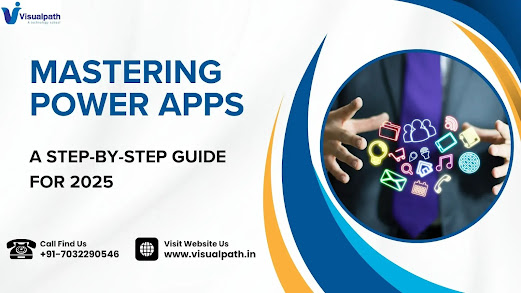- Get link
- X
- Other Apps
In today’s digital transformation era, businesses need custom applications to improve productivity and efficiency. Microsoft Power Apps enables users to build low-code applications that integrate with Microsoft 365, Dynamics 365, and other services. Whether you’re a beginner or an experienced developer, this guide will help you master Power Apps in 2025 with best practices and step-by-step instructions.
What
is Power Apps?
Power Apps is a low-code application development platform by Microsoft that allows
users to create business applications without extensive coding. It offers three
types of apps:
·
Canvas Apps – Highly customizable apps with a
drag-and-drop interface.
·
Model-Driven Apps – Apps based on Microsoft Dataverse
for structured data-driven applications.
·
Power Pages – Used for building external-facing
web portals.
By mastering
Power Apps, you can digitize business processes, streamline workflows, and
create applications that connect with multiple data sources. PowerApps Training in Hyderabad
Getting
Started with Power Apps
1. Set up Your Power Apps Account
To start
building apps, sign in to Power Apps with your Microsoft 365 account. If you don’t have an account, you can start with a free trial.
2. Understanding the Power Apps
Interface
When you log
in, you will see:
·
Home
Dashboard – Quick access to apps, templates, and learning resources.
·
Apps
Section – Where you create and manage your applications.
·
Data
Section – Connect to data sources like SharePoint,
SQL, and Excel.
·
Flows
– Integrate with Power Automate to add automation.
3. Choosing the Right App Type
·
Use
Canvas Apps if you want full design control.
·
Use
Model-Driven Apps for structured data and predefined components.
·
Use
Power Pages if you need an external-facing portal.
Step-by-Step
Guide to Building Your First Power App
Step 1: Choose a Template or Start
from Scratch
Power Apps
provides pre-built templates that help you get started quickly. Alternatively, you can
start from a blank canvas.
Step 2: Connect to Data Sources
Power Apps
integrates with multiple data sources like:
·
SharePoint
·
Microsoft
Dataverse
·
SQL
Server
·
OneDrive
& Excel
·
Power
Automate
Step 3: Design Your App
Use the
drag-and-drop builder to add elements such as:
·
Text
fields
·
Buttons
·
Dropdowns
·
Galleries
Step 4: Add Logic and Automation
You can use
Power Fx, a simple formula-based language, to add logic to your app.
Additionally, integrate with Power Automate to automate workflows, such as
sending emails or notifications.
Step 5: Test and Publish Your App
Before
publishing:
·
Use
the preview mode to test functionality.
·
Share
the app with your organization.
·
Publish
it for use on desktop and mobile devices.
Best
Practices for Mastering Power Apps
1. Use Microsoft Dataverse for
Scalability
For
large-scale applications, use Dataverse instead of Excel or SharePoint to
handle structured data efficiently.
2. Optimize Performance
·
Limit
the number of data connections.
·
Use
delegation-friendly functions.
·
Minimize
on-premises data gateway usage for better speed.
3. Enhance Security
·
Implement
role-based access control (RBAC).
·
Use
environment security policies.
·
Encrypt
sensitive data.
4. Leverage Power Automate for
Workflow Automation
Power
Automate helps automate repetitive tasks like:
·
Approvals
and notifications
·
Data
synchronization
·
Email
automation
Advanced
Features to Explore in 2025
Leverage
AI-powered automation by integrating AI models to analyze images, text, and
business data.
Power Apps
Portals (Now Power Pages)
Build
external-facing applications for customers, vendors, and partners with Power
Pages.
Integration
with Power BI
Use Power BI dashboards inside Power Apps to provide
real-time analytics and insights.
Conclusion
Mastering Power Apps in 2025 will give you the ability to
build business applications, automate workflows, and improve productivity
without deep coding knowledge. By following this guide, you’ll be able to
create custom Power Apps solutions that enhance efficiency and innovation in
your organization. Start today and become proficient in Power Apps, Power
Automate, and Dataverse!
Trending
Courses: Generative AI, Prompt Engineering,
Visualpath stands out as the
leading and best institute for software online training in Hyderabad. We
provide Power Apps
and Power Automate Training. You will get the best course at
an affordable cost.
Call/What’s App – +91-7032290546
- Get link
- X
- Other Apps

Comments
Post a Comment